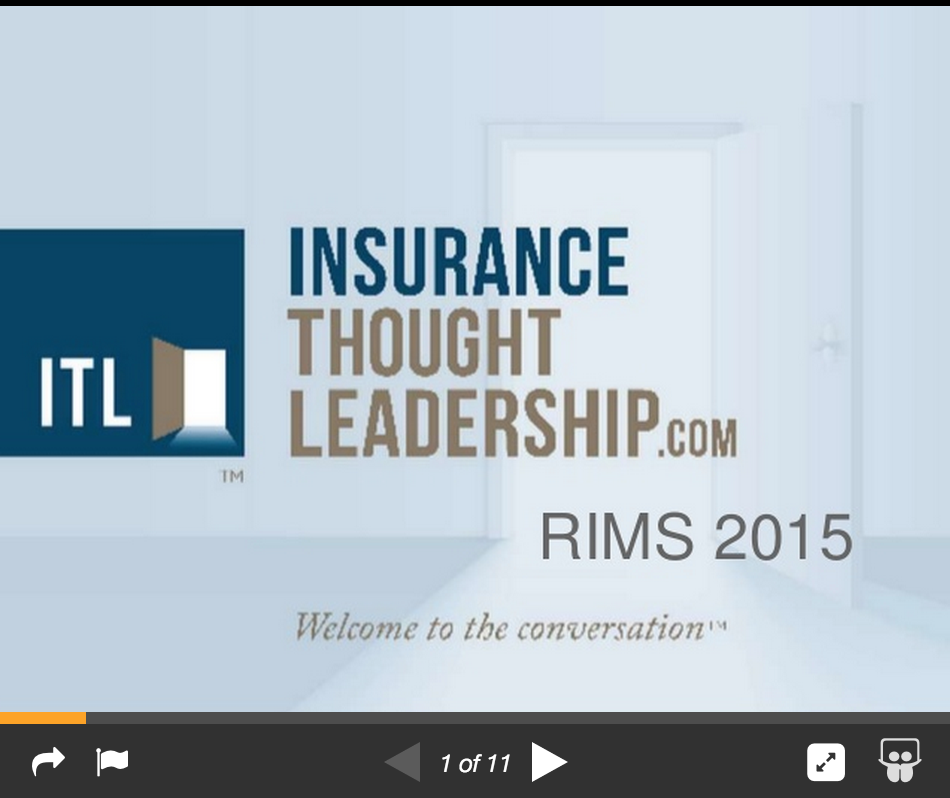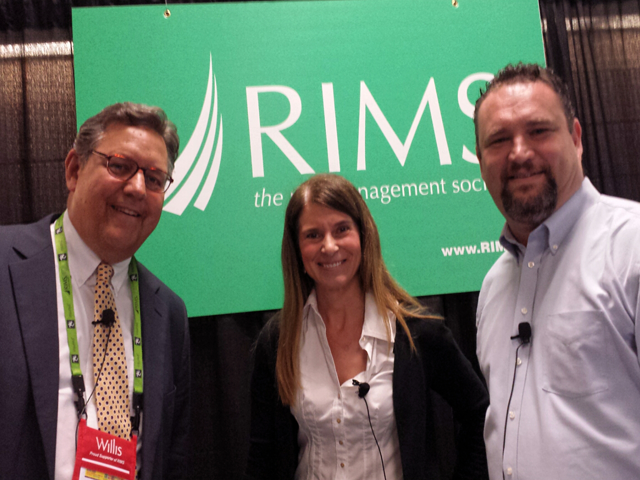This summarizes a session from RIMS that was headlined by Google Risk Manager Kelly Crowder as well as Google Global Safety Manager Erike Young. I served as the event host and moderator, teeing up the subject matter. We focused on four major areas of technology that are driving transformative change in the way we do things and, thus, changing risk. Disruptive technology, as the panel pointed out, forces risk managers and insurers to imagine and forecast how various advancements affect: safety; risk assessment; regulatory and legal parameters; and insurance implications.
Albert Einstein set the course for the future when he said: “The true sign of intelligence is not knowledge but imagination.” Ideas can reach beyond probable or practical restraints.
Google takes that notion to heart at Google X, a semi-secret lab located in Silicon Valley that aims via research and development to advance scientific knowledge and fuel discoveries that can change the world. “What if” abstract concepts, also known to Google as “moonshots,” are tireless experiments that often fail but that occasionally produce disruptive technology. The mantra is “fail fast, fail often, fail forward.” Learn and change. Sergey Brin, one of Google’s co-founders, and scientist Astro Teller (Captain of Moonshots) seek to improve existing technologies by a factor of 10. Google began with the self-driving car in 2010. Google X now includes a life sciences division involved in bionics.
As with the radical transportation shift to horseless carriages 130 years ago, the technologies are changing risk in profound ways, but the positive and negative impact of new technology can be hard to predict.
Starting with
Botsourcing and Robotics, the panel highlighted the trend of companies to utilize robots and artificial intelligence for a wide array of service industries, manufacturers, medical providers and first responders, which seek safer, more efficient and cost-effective ways of serving clients or conducting business. While more dangerous occupational risks and blue-collar jobs are expected to be safer and more efficient, it remains uncertain whether the demand for labor will continue to grow as technology marches forward. Within 10 years, more than 40% of the workforce is expected to be affected by or replaced with robotics.
One positive sign noted in the presentation is that many American companies using robotics and 3D printing technologies, are transferring production facilities from overseas back to the U.S. and creating homeland jobs in the process. New job skills will become necessary to sustain broad-based prosperity. With respect to the highly advanced robots expected to integrate into society, the panel if their cognition will ever replace emotionally oriented skills. Will the warmth of human interaction remain a value in the future?
Another area of advancement is
Surveillance and Wearable Biometrics. The Internet of Things represents the embedding of physical objects with sensors and connectivity. Devices like smart thermostats, as Google pointed out, are able to learn from our behavior patterns to anticipate our needs at home or work on a 24- hour basis. Our security and monitoring systems are tied to public safety, medical providers and our smartphones. Data collection is growing at an enormous pace, effectively tracking our every move. This, as pointed out, has created concern for privacy and for the increasing vulnerability to cyber threats.
Fixed and mobile surveillance cameras have facial identification technology. Unmanned aerial vehicles (UAV’s), also known as drones, can be preprogrammed to operate autonomously, although the panel pointed out that current FAA restrictions require an operator following visual line-of sight rules below 400 feet of altitude. It’s expected that, within the next few years, there will be autonomous drone surveillance and product delivery systems.
Utilities can use drones to monitor power transmission lines at 1/10
th the cost of a helicopter and with safety and efficiency impossible with helicopters. Public safety departments can use UAVs to assess damages as well as risks. Four U.S. insurers are currently using human-operated drones to assess property damage claims arising from natural disasters. The panel showed photos of UAVs that look like insects that are the size of a fingertip.
Wearable biometrics are much more sophisticated than Apple watches and Fitbits. Google explained the company’s quest to improve health monitoring systems. With 9.3% of the U.S. population alone (29 million) suffering from diabetes, Google sells a revolutionary contact lens, developed with Novartis, that monitors glucose levels and corrects vision similar to an autofocus camera. Other panel photos show tattoo-like patches thinner than a human hair that stick to the skin. Using microfluidic construction, these nearly invisible patches monitor EKG and EEG bodily functions and transmit the data 24/7 wirelessly. Similar monitors, known as
smarty pants, can be sewn into underclothes and bras.
Exoskeleton Technologies are being developed by more than a dozen major manufacturers, as the panel demonstrated, and their products are expanding human capacity and endurance far beyond most expectations. These are wearable machines that combine human intelligence and machine power to achieve nearly any conceivable task without falling. Used by the military, public safety, hazmat teams and industries and for medical rehabilitation, exoskeletons let humans perform feats that would have been physically impossible a few years ago. Neuro interfaces with bio-logical signals allow paraplegics to relearn lost functions. Some patients can actually experience running a four-minute mile or play certain sports. Lifting is painless and commonplace with weights of 40 to 60 pounds, with new technology allowing a person to run without falling down with 200 pounds of weight on their back. A la “Iron Man,” exoskeleton suits are being designed into wearable fabrics with micro energy packs.
This area of technology has the greatest potential of protecting workers from soft tissue strains and back injuries. In addition, it serves a dual purpose of advancing an injured worker’s rehabilitation and recovery process without the inherent risk of getting reinjured. As pointed out, experts expect industrial injuries to be reduced as much as 70% as exoskeleton technology is woven into the workplace as personal protective equipment (PPE). Perhaps a bigger question, with an aging workforce and population, is the unknown cost and whether employers, insurers or individuals will bear the expense.
The fourth and final technology covered by the panel was
Autonomous Transportation Systems and Devices. Google pioneered self-driving vehicles and leads in the development of its associated technology, but autonomous vehicles are now being produced and tested by a growing number of manufacturers. In March 2015, Delphi sent a driverless Audi SUV on a 3,400-mile trip through 15 states from San Francisco to New York City in eight days without an accident. Auto manufacturers are approaching self-driving features on an incremental basis with self-braking, self-parking and other autonomous safety-related features. Google has inspired a jump to a fully autonomous vehicle with no steering wheel or brake. These self-driving vehicles perform 7,000 safety processes per second at high speeds with far safer results than any human driver.
The impact of self-driving vehicles, including trucks, is expected to be commonplace within 20 years or sooner. A recent national survey of drivers indicated 44% are looking forward to autonomous vehicles. Respondents cited safety as their first priority. Their second reason was their expectation that they would not be paying for car insurance, which averages $820 per licensed vehicle per year in the U.S. Statisticians expected a drastic reduction of injuries as well as reduced violations like DUI, speeding and running red lights. With 35,000 motor vehicle deaths each year in the U.S., increased safety coupled with increased freeway efficiencies of ultimately more than 10 fold are issues that will make this a disruptive technology that will seem long overdue.
As the Google risk management team pointed out, insurers don’t know how to react or respond to the inevitable switch to autonomous vehicles. Even on a road test basis, auto insurance underwriters are scratching their heads trying to assess the risk implications.
As the panel pointed out to the inquisitive audience during the Q&A session, it may be relatively simple to determine the impact of new technology from a measurable, scientific basis. But the big challenge for risk managers is imagining the implications these various technological advancements will have on our organizations, workforce and insurers. Auto insurers have at least $500 billion in annual premiums at stake in the U.S. alone. What will happen to that revenue when we shed our need to get behind the wheel every day?
Google also pointed out that each of the technological areas cover a wide range of regulatory implications. While they attempt to notify every conceivable regulatory entity as they develop and test new products, it’s clear that there often aren’t clear legal or regulatory guidelines in place. How will regulators be able to promulgate new rules, regulations and laws as these science fiction-like inventions come to reality?
As Dr. Seuss said so profoundly, “Think and Wonder. Wonder and Think.”
ITL and its 400-plus thought leaders are providing the kind of wisdom and insight we will need to help bring all the parties together to solve these challenges. We welcome you to the conversation.






